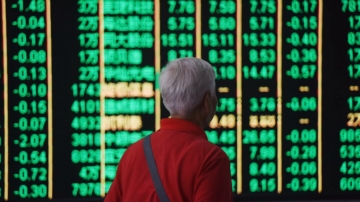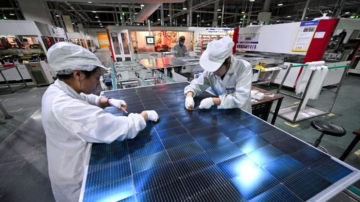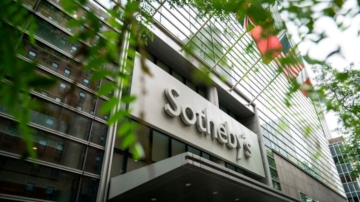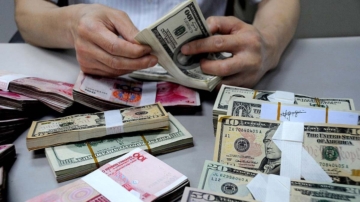【新唐人2014年02月18日讯】法国银行业巨头“兴业银行”警告说,2014年中国经济“硬着陆”风险增大。有专家甚至指出,代表国民生产总值的中国GDP增速,可能下降到2%。下面请看专家分析。
据《美国之音》报导,法国“兴业银行”日前发表的报告中估计,中国今年的经济增长率为6.9%,低于中国政府设立的7.5%的目标和国际货币基金组织的预期,“硬着陆”的风险正在增加。
“兴业”对中国2014年“硬着陆”的定义为﹕全年GDP实际增长率跌到5%以下。这个机构认为,这是维持就业市场稳定,避免系统性金融风险的最低限度。
“兴业银行”经济师帕特里克•莱格兰德公开指出,危机最严重时,经济同期增长率可能会下降到2%。
中国金融智库研究员巩胜利:“它两难境地,一个是货币投放量历史最高,02年的时候,人民币的货币总量大概只有16万亿,现在是110万亿,还有一个参照,中国的GDP只有美国的差不多一半,但是中国花出去的货币是美国的1.5倍,中国还一直在喊钱紧钱紧。”
按照惯例,每年的12月份和1月份,都是中国销售和生产的最高峰期,但是,据中共官方公布的数字,去年12月,中国经济发展速度下降到7.7%,而应该在2月12号公布的今年1月份GDP指数,现在还没有公布,据说是因为GDP数字太难看。
1月21号,人民币兑美元吃紧,央行放水2500亿救市,2月1号到2月12号之间,人民币对港币的牌价连续跌了10天,跌幅超过7%,去年全年,人民币对美元的升幅只有3%。
巩胜利:“美国的货币投放现在才减少了200亿,现在(中国)就到了强力拉不开栓,人走不动路,马失前蹄,掉下来,如果美国每个月850亿全部退出,又会造成甚么样的结果?”
根据中国银监会星期四公布的数据,去年第四季度,中国商业银行“不良贷款馀额”为5921亿元,比第三季度增长了285亿元,连续九个季度上升。
巩胜利:“背后的还有一些,因为中国的商业银行,特别是四大家,他们都是股份制上市企业,他们的那些坏资产,死的资产已经都剥离了,现在又从新堆积了它的债务,每一家银行后面都有一个资产管理公司,处理以前的债务,他的债务关键是在那边了,那边你看不到。”
美国南卡罗莱纳大学艾肯商学院教授谢田:“更难办的问题是影子银行的问题,理财产品大面积的违约恐怕马上就会到来,政府是不是去救助,救助到甚么程度,这些理财产品涉及到影子银行的问题,涉及到地方债的问题,这些总体债务的迸发才是更大的问题。”
许多分析师相信,中国真实的不良贷款比例比官方公布的数字更高,因为银行可以通过“借新债还旧债”来掩盖坏账。
而据中共国家统计局最近公布的数字,代表工业生产者出厂价格指数的PPI同比下降1.6%,连续下降了23个月,接近两年。而全国居民消费价格总水平却同比上涨了2.5%。
巩胜利:“货币的成本高,其他所有的行业成本就高起来,成本高了以后,一个是使用货币的人,他使用不起,成本高,还有一个,如果企业不能够很好的使用货币,银行的呆账、死账、烂账就会增加, 持续走下去的话,债务链接越接越大,最后脱不动了,只有死亡。”
目前中国银行的货币利率达到6.2%左右,在全球20个大国中,中国的货币运行成本是最高的,美国的利率维持在0到0.25% 。
不过中国金融智库研究员巩胜利指出,如果中国经济崩盘,对全球不会产生太大影响,因为中国经济只占全球的7%,而货币影响更小,储备货币只占0.1%,每一天在全球的人民币运行只相当于1880亿美金。巩胜利说,美国的经济对全球影响非常大,因为美国的经济占全球的20%,而美元每天在全球的运行达到4万6000亿之多。
采访编辑/刘惠 后制/孙宁
Expert: China Hard Landing with Expected 2% GDP Growth
French banking giant Societe Generale (SocGen) warned China of the risk of a hard landing in 2014. It is analyzed that China's GDP might drop to 2%.
The following is the experts' analysis.
It is reported that SocGen has recently estimated a 6.9% economic growth for China this year, below the consensus 7.5% and the risk of hard landing is mounting.
According to Societe Generale, a hard landing scenario would see full-year, real GDP growth fall below 5%, a level believed to be the minimum to maintain the market and avoid financial crisis.
Societe Generale's Patrick Legland thinks at the peak of a crisis the year-on-year growth rate would dip to 2%.
Gong Shengli, Chinese financial think tank researcher:
"This is a dilemma. For one, the cash injection has been the historic high.
There was about 16 trillion RMB in circulation in 2002, now it is 110 trillion RMB. And the other is that China's GDP, about half of the United States,
but China spends at 1.5 times as much as the United States, and China is still complaining of tight cash flow."
In China, both December and January are the peak for sales and production.
Recent official data showed China's economic growth rate dropped to 7.7% last December. While the January data supposed to be reported on Feb. 12
has not been released. It is said that it is because the GDP was too low to show.
On January 21, the RMB to the U.S. dollar went down and forced the central bank to inject 250 billion RMB to save the market.
Between Feb. 1 and Feb. 12, the RMB against the Hong Kong dollar fell continuously for 10 days, with a decline of more than 7%, while throughout last year the RMB against U.S. dollar rose only by 3%.
Gong Shengli: "America's money supply was only reduced by 20 billion and China has started to tumble. What would happen if the United States completely withholds its monthly 85 billion printing now?"
According to China Banking Regulatory Commission's release Thursday, the fourth quarter of last year, the balance of non-performing loans of Chinese commercial banks was 592.1 billion yuan, accounted for an increase of 28.5 billion yuan
from the third quarter, and the growth for ninth consecutive quarters.
Gong Shengli: "There are also debts hidden. China's commercial banks, especially the four major banks, are joint-stock companies. Their dead debts had been written off as uncollectable and managed by the asset management company. However, the banks continue to build new debts. The key is in the debt at the management company, but we don't get to see it."
Xie Tian, School of Business Professor, University of South Carolina Aiken: "The shadow bankings are even more difficult to handle. Massive default on the trust products is probably just around the corner. Will the government intervene and to what extent? These trust products are related to the shadow bankings and
local debts. The overall debt outbreaks will impose the major crisis."
Analysts believe that the non-performing loans are much higher than the official data, because banks tend to cover up bad debt by refinancing the old debts.
The Chinese National Bureau of Statistics revealed the January producer price index (PPI) for manufactured goods decreased 1.6 percent year-on-year, and decreased for 23 consecutive months, whereas the consumer price index (CPI)
went up by 2.5 percent year-on-year.
Gong Shengli: "The high money cost raises all costs at the industries. People will not be able to afford the high cost is for one, and the industries will not have an effective use of the money and increase banks' bad debts. In the long run, the debt chain will only grow and finally kill the entire system."
China banks' currency rate is around 6.2%. Among the 20 major countries in the world, China's currency has the highest operating costs, whereas the U.S. interest rates remain at 0 to 0.25%.
But Chinese financial think tank researcher Gong Shengli indicates that in the event of China's economic collapse, the impact on the global economy will not be much, because China's economy accounts for only 7% of the world.
The currency effect is even smaller, because its reserve currency takes only 0.1%, and daily circulating RMB is only accounted for 188 billion dollars.
However, the U.S. economy will have a major impact to the world for it occupies 20 % of the world economy, and daily circulating U.S. dollar is as high as 4.6 trillion.
Interview & Edit/LiuHui Post-Production/SunNing
据《美国之音》报导,法国“兴业银行”日前发表的报告中估计,中国今年的经济增长率为6.9%,低于中国政府设立的7.5%的目标和国际货币基金组织的预期,“硬着陆”的风险正在增加。
“兴业”对中国2014年“硬着陆”的定义为﹕全年GDP实际增长率跌到5%以下。这个机构认为,这是维持就业市场稳定,避免系统性金融风险的最低限度。
“兴业银行”经济师帕特里克•莱格兰德公开指出,危机最严重时,经济同期增长率可能会下降到2%。
中国金融智库研究员巩胜利:“它两难境地,一个是货币投放量历史最高,02年的时候,人民币的货币总量大概只有16万亿,现在是110万亿,还有一个参照,中国的GDP只有美国的差不多一半,但是中国花出去的货币是美国的1.5倍,中国还一直在喊钱紧钱紧。”
按照惯例,每年的12月份和1月份,都是中国销售和生产的最高峰期,但是,据中共官方公布的数字,去年12月,中国经济发展速度下降到7.7%,而应该在2月12号公布的今年1月份GDP指数,现在还没有公布,据说是因为GDP数字太难看。
1月21号,人民币兑美元吃紧,央行放水2500亿救市,2月1号到2月12号之间,人民币对港币的牌价连续跌了10天,跌幅超过7%,去年全年,人民币对美元的升幅只有3%。
巩胜利:“美国的货币投放现在才减少了200亿,现在(中国)就到了强力拉不开栓,人走不动路,马失前蹄,掉下来,如果美国每个月850亿全部退出,又会造成甚么样的结果?”
根据中国银监会星期四公布的数据,去年第四季度,中国商业银行“不良贷款馀额”为5921亿元,比第三季度增长了285亿元,连续九个季度上升。
巩胜利:“背后的还有一些,因为中国的商业银行,特别是四大家,他们都是股份制上市企业,他们的那些坏资产,死的资产已经都剥离了,现在又从新堆积了它的债务,每一家银行后面都有一个资产管理公司,处理以前的债务,他的债务关键是在那边了,那边你看不到。”
美国南卡罗莱纳大学艾肯商学院教授谢田:“更难办的问题是影子银行的问题,理财产品大面积的违约恐怕马上就会到来,政府是不是去救助,救助到甚么程度,这些理财产品涉及到影子银行的问题,涉及到地方债的问题,这些总体债务的迸发才是更大的问题。”
许多分析师相信,中国真实的不良贷款比例比官方公布的数字更高,因为银行可以通过“借新债还旧债”来掩盖坏账。
而据中共国家统计局最近公布的数字,代表工业生产者出厂价格指数的PPI同比下降1.6%,连续下降了23个月,接近两年。而全国居民消费价格总水平却同比上涨了2.5%。
巩胜利:“货币的成本高,其他所有的行业成本就高起来,成本高了以后,一个是使用货币的人,他使用不起,成本高,还有一个,如果企业不能够很好的使用货币,银行的呆账、死账、烂账就会增加, 持续走下去的话,债务链接越接越大,最后脱不动了,只有死亡。”
目前中国银行的货币利率达到6.2%左右,在全球20个大国中,中国的货币运行成本是最高的,美国的利率维持在0到0.25% 。
不过中国金融智库研究员巩胜利指出,如果中国经济崩盘,对全球不会产生太大影响,因为中国经济只占全球的7%,而货币影响更小,储备货币只占0.1%,每一天在全球的人民币运行只相当于1880亿美金。巩胜利说,美国的经济对全球影响非常大,因为美国的经济占全球的20%,而美元每天在全球的运行达到4万6000亿之多。
采访编辑/刘惠 后制/孙宁
Expert: China Hard Landing with Expected 2% GDP Growth
French banking giant Societe Generale (SocGen) warned China of the risk of a hard landing in 2014. It is analyzed that China's GDP might drop to 2%.
The following is the experts' analysis.
It is reported that SocGen has recently estimated a 6.9% economic growth for China this year, below the consensus 7.5% and the risk of hard landing is mounting.
According to Societe Generale, a hard landing scenario would see full-year, real GDP growth fall below 5%, a level believed to be the minimum to maintain the market and avoid financial crisis.
Societe Generale's Patrick Legland thinks at the peak of a crisis the year-on-year growth rate would dip to 2%.
Gong Shengli, Chinese financial think tank researcher:
"This is a dilemma. For one, the cash injection has been the historic high.
There was about 16 trillion RMB in circulation in 2002, now it is 110 trillion RMB. And the other is that China's GDP, about half of the United States,
but China spends at 1.5 times as much as the United States, and China is still complaining of tight cash flow."
In China, both December and January are the peak for sales and production.
Recent official data showed China's economic growth rate dropped to 7.7% last December. While the January data supposed to be reported on Feb. 12
has not been released. It is said that it is because the GDP was too low to show.
On January 21, the RMB to the U.S. dollar went down and forced the central bank to inject 250 billion RMB to save the market.
Between Feb. 1 and Feb. 12, the RMB against the Hong Kong dollar fell continuously for 10 days, with a decline of more than 7%, while throughout last year the RMB against U.S. dollar rose only by 3%.
Gong Shengli: "America's money supply was only reduced by 20 billion and China has started to tumble. What would happen if the United States completely withholds its monthly 85 billion printing now?"
According to China Banking Regulatory Commission's release Thursday, the fourth quarter of last year, the balance of non-performing loans of Chinese commercial banks was 592.1 billion yuan, accounted for an increase of 28.5 billion yuan
from the third quarter, and the growth for ninth consecutive quarters.
Gong Shengli: "There are also debts hidden. China's commercial banks, especially the four major banks, are joint-stock companies. Their dead debts had been written off as uncollectable and managed by the asset management company. However, the banks continue to build new debts. The key is in the debt at the management company, but we don't get to see it."
Xie Tian, School of Business Professor, University of South Carolina Aiken: "The shadow bankings are even more difficult to handle. Massive default on the trust products is probably just around the corner. Will the government intervene and to what extent? These trust products are related to the shadow bankings and
local debts. The overall debt outbreaks will impose the major crisis."
Analysts believe that the non-performing loans are much higher than the official data, because banks tend to cover up bad debt by refinancing the old debts.
The Chinese National Bureau of Statistics revealed the January producer price index (PPI) for manufactured goods decreased 1.6 percent year-on-year, and decreased for 23 consecutive months, whereas the consumer price index (CPI)
went up by 2.5 percent year-on-year.
Gong Shengli: "The high money cost raises all costs at the industries. People will not be able to afford the high cost is for one, and the industries will not have an effective use of the money and increase banks' bad debts. In the long run, the debt chain will only grow and finally kill the entire system."
China banks' currency rate is around 6.2%. Among the 20 major countries in the world, China's currency has the highest operating costs, whereas the U.S. interest rates remain at 0 to 0.25%.
But Chinese financial think tank researcher Gong Shengli indicates that in the event of China's economic collapse, the impact on the global economy will not be much, because China's economy accounts for only 7% of the world.
The currency effect is even smaller, because its reserve currency takes only 0.1%, and daily circulating RMB is only accounted for 188 billion dollars.
However, the U.S. economy will have a major impact to the world for it occupies 20 % of the world economy, and daily circulating U.S. dollar is as high as 4.6 trillion.
Interview & Edit/LiuHui Post-Production/SunNing








